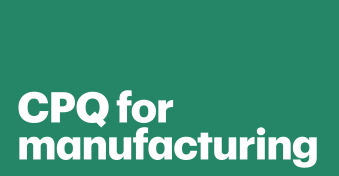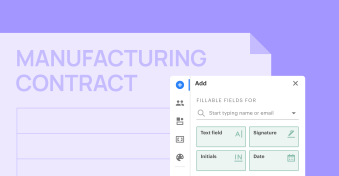OEM agreements are how businesses source pre-built product components and guarantee they’ll fit the spec.
They’re pretty far-reaching and are generally reserved for long-term business partnerships in high-tech industries — so it’s important to get them right.
In this article, we explain what makes a solid OEM agreement and what to include in yours.
Key takeaways
- OEM agreements, or Original Equipment Manufacturer agreements, are a key concept for businesses that produce and sell physical products.
- A solid OEM agreement minimizes the risk of disputes by clearly outlining product specifications, quality standards, and delivery timelines.
- The scope of OEM agreements varies from simple supply arrangements to more complex partnerships that cover aspects like design or software integration.
- Properly drafted OEM agreements protect intellectual property rights and safeguard both the buyer’s and manufacturer’s interests.
- PandaDoc streamlines the OEM agreement process, offering customizable templates and seamless integration with your CRM system.
What is an OEM agreement?
So, let’s define an OEM agreement. An OEM agreement is a deal between two companies where one supplies pre-built parts to the other, which then incorporates them into its own products to be sold under a different brand name.
These agreements are a big reason why, when you search for a product on marketplaces like Amazon, you might encounter dozens of alternatives that appear strikingly similar — often because they’re produced by the exact same manufacturing partners.
And what’s more. This isn’t always obvious to consumers because the specifics of product origin remain hidden behind NDA clauses.
However, from a business perspective, OEM contracts are extremely useful. They mean products can be made to a higher quality for a lower price and quicker time-to-market.
You don’t need your own factory to build all your small parts — OEMs guarantee that your components meet safety standards and match the quality your customers expect.
The background of OEM agreements
Now, a little history lesson. The concept of OEM agreements isn’t exactly new; it’s rooted in older legal concepts like contracts-for-goods or licensing and distribution agreements.
However, the term “OEM” really started to pick up steam in the computer hardware industry in the 1990s when manufacturers would include third-party components in their PCs — such as Windows OS coming pre-installed on a hard drive or an Intel processor being housed in a proprietary computer case.
The danger of a bad OEM agreement
The key point is that OEM components require specialized knowledge and R&D capabilities to produce.
For this reason, you see OEM agreements in all sorts of high-tech industries, from automotive to electronics, where they help companies expand their product lines without reinventing the wheel.
But you’ve also got to watch out for the pitfalls — namely, poorly written contracts.
A bad OEM agreement can lead to quality issues, supply chain nightmares, and finger-pointing if things go wrong.
How do OEM agreements work?
An OEM agreement is much more far-reaching than a standard purchase contract.
Not only does it go into more technical detail on product specification, but it also establishes legally binding commitments between the parties on things like recurring supply or usage limitations.
For instance, the buyer needs assurances that the product meets industry-certified standards — otherwise, it reflects poorly on their brand name if a component stops working.
It’s why OEM agreements include enforcement mechanisms in the event of non-compliance, such as dispute mediation services or stipulated financial penalties.
You also need to bear in mind that the scope of OEM agreements can vary significantly depending on the product type and circumstances of the business arrangement. Here are some of the main contract types you may encounter:
- Traditional OEM: A straightforward manufacturing and supply agreement.
- VAR (Value-Added Reseller): The reseller adds features or services to the original product before reselling it.
- Private label: Products manufactured by one company are sold under another company’s brand.
- Design and manufacture: One party designs the product, while the other manufactures it.
- Component supply: One company supplies components to another to assemble a final product.
- Software OEM: In this arrangement, software developers provide their products to hardware manufacturers, who then bundle the software with their hardware products.
- OEM parts distribution: Here, a manufacturer produces parts exclusively for distribution by a retailer, often under that marketplace’s branding.
Which business areas can OEM agreements impact?
For many businesses, getting an OEM agreement over the line can make or break their product offerings.
It would come as no surprise that OEMs can have a large impact across business departments.
Let’s take a look at the business areas that OEMs can affect.
Product development
The first stage of any product lifecycle is to design its appearance and features.
The type of OEM agreement is a major factor influencing these product development choices and the extent of customization possible.
Let’s go back to that example of designing PCs using components from several third-party manufacturers.
If a product dev team wants to make a gaming PC, they would probably opt for a design and manufacture OEM because it allows more detailed specifications on product performance and aesthetics.
On the other hand, a traditional OEM approach would be more suited for general-use products with limited buyer input on design and features.
Supply chain
OEM contracts also play a big role in supply chain management. This is because some products might be impossible to produce in-house, and switching suppliers could mean certain components aren’t compatible.
As such, buyers must find reliable external suppliers that will agree to long-term OEM deals; otherwise, their products could be rendered obsolete as soon as they hit the shelves.
Another key area that supply chain managers must grapple with is sales and operations planning. This involves forecasting product demand, which informs a company of how many units need to be produced and, consequently, how many components need to be ordered.
For instance, if a company projects a surge in demand for gaming PCs due to a hotly-anticipated video game release, it might adjust its OEM agreements to secure more high-performance graphics cards and processors ahead of time.
Branding, marketing, and sales
In most cases, OEM agreements provide significant freedom for the product buyer to brand the finished products as their own — a concept that’s a cornerstone of private label strategies.
However, there are exceptions to the rule, and some contracts might dictate that the original manufacturer’s logo be displayed alongside the buyer’s branding.
The rules can be even stricter where user safety is concerned.
For example, there might be a requirement that marketing materials require prior approval to verify the technical accuracy of a product.
Imagine that a product was wrongfully advertised for unintended purposes — an electric flaw could put the user’s health at risk and harm the manufacturer’s reputation, even if it wasn’t their fault.
OEM agreement template: common components
Having an OEM agreement template at the ready means you can get deals signed faster and not worry that you’re missing anything crucial. Here’s what you should include in yours:
1. Product or component specifications
The first section of an OEM agreement template is usually called something like Specifications and Requirements. Here, the product specs are outlined in clear and extensive terms — covering everything from dimensions and production materials to acceptable performance criteria.
This section ensures you and your manufacturer are on the same page about what you’re creating, minimizing confusion or the risk of a dispute.
It also helps when it comes to determining payment terms.
For example, if your sales teams use CPQ for manufacturing, a carefully worded OEM can acknowledge that prices can vary when made to slightly altered specs as requested.
2. Quality control processes and standards
The Quality Assurance and Control section details the quality assurance measures the manufacturer must adhere to.
This includes the methods and frequencies of testing, the standards that products must meet (such as ISO certifications), and how non-conformance issues will be handled.
For instance, it could suggest a course of action, like a referral to an independent mediator, should the quality of a product not meet agreed-upon requirements.
3. Supply relationship
The Supply and Delivery Terms section covers the logistical aspects of the OEM agreement, including production lead times, when products are delivered, and how they’re handled.
This essentially sets the ground rules for how orders will run on time. It might also detail penalties for delays or mechanisms for handling supply disruptions where it’s not the manufacturer’s fault.
If implemented correctly, a solidly written supply clause means your stock levels will always be just right, avoiding stock shortages and warehouse excess.
4. Intellectual property rights
The IP and Licensing section safeguards innovations and trademarks.
It outlines intellectual property ownership, protecting your creative assets, and ensuring you don’t cross a line by claiming the manufacturer’s designs as your own.
Clauses in this section safeguard the buyer’s rights to use the manufacturer’s IP within the scope of the agreement and ensure there aren’t any infringement disputes.
5. Training and technical support
The Support and Training Services section ensures the manufacturer doesn’t just drop off the product and run. It commits them to ongoing support, such as teaching your team how to construct, maintain, and troubleshoot known issues with the component.
This sets up your customer service team to effectively help users navigate the product—meaning you’re more likely to receive positive reviews and a strong brand image.
As a side note, these clauses are especially common for software applications, as they require regular security patches to protect against threats like day-one exploits or viruses.
6. Warranties and liabilities
Finally, the Warranties and Indemnities are the manufacturer’s promises about your product’s quality. This is your safety net, ensuring that product faults are quickly and fairly resolved. It outlines who is responsible for what if a product doesn’t meet the grade or breaks down.
Best practices for drafting an effective OEM agreement
Writing an OEM agreement can seem daunting, especially if it’s your first time. Follow our best practices to ensure your document sets the stage for success.
Tailor the agreement to your business and product(s)
First off, you need to consider what kind of product you’re trying to develop and sell.
This is an exercise in business strategy, and you need to consider two broad areas when writing OEM agreements to support your objectives.
These are:
- Product lifecycle: Is this product a short-term solution addressing a current trend, or does it have the potential for long-term relevance? If you’re unsure, it’s best to avoid fixed-term deals and try to negotiate rolling contracts instead.
- Product quantities: Will this product appeal to your established customer base or attract a new segment? This is a question of risk. If you don’t know how much of this product you can sell, it’s a good idea to err on the side of caution.
Maintain clarity throughout
Clarity is non-negotiable in any legal document. A well-drafted OEM agreement should be straightforward—easy to read and understand.
However, hitting the mark is tough when faced with technical specifications and precise legal language.
It’s easy to keep things clear with document workflow software.
Our solution simplifies document generation and provides 1000s of business templates with ready-made clauses on topics like product specifications, quality assurance, and delivery schedules.
All you have to do is fill in the details of what you need.
Ensure you consider industry and location-specific regulations
Compliance is crucial in OEM agreements, especially when dealing with products that can potentially be hazardous to the end user.
For example, in the electronics industry, following safety standards like CE (Europe) or FCC (USA) is mandatory. Similarly, environmental regulations, such as RoHS in the European Union, prohibit the use of certain dangerous substances in manufacturing processes.
Incorporating these regulations into your agreement ensures that your end is covered — avoiding legal difficulties and making your product more attractive to potential customers.
PandaDoc can help you create, share, and track OEM agreements and more besides
To wrap up, OEM agreements are really useful for businesses looking to scale quickly without the hassle of making every component in-house.
They go into much more detail than your standard contract-for-goods and cover topics like supply chain relationships, intellectual property rights, and product warranties/liabilities.
Ultimately, this is a good thing because a poorly worded contract can do more harm than good.
To ease the burden, OEM buyers and suppliers trust document workflow software like PandaDoc.
Our software helps businesses throughout the contract lifecycle, from document creation to signing and renewal.
Plus, PandaDoc integrates with your CRM solution, meaning client information is automatically imported into your documents.
This reduces the workload during OEM proposals, empowering you to work with multiple suppliers and never slip up on the details. Get started with a 14-day free trial.
Disclaimer
PandaDoc is not a law firm, or a substitute for an attorney or law firm. This page is not intended to and does not provide legal advice. Should you have legal questions on the validity of e-signatures or digital signatures and the enforceability thereof, please consult with an attorney or law firm. Use of PandaDoc services are governed by our Terms of Use and Privacy Policy.


